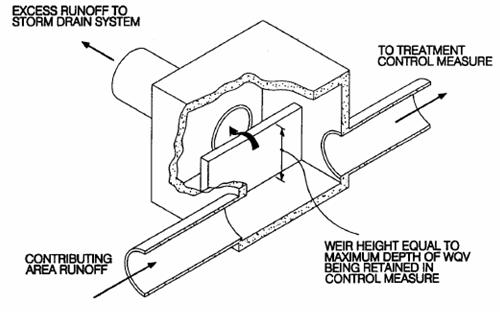Flow Splitter
From MassHighway Stormwater Handbook for Highways and Bridges
http://166.90.180.162/mhd/downloads/projDev/swbook.pdf
Description

A flow splitter is an engineered structure used to divide flow into two or more parts, and divert these parts to different places. The design of a flow splitter uses specifically designed structures, pipes, orifices, and weirs set at specific elevations to control the direction of flow. An illustration of a simple type of flow splitter is provided in the accompanying figure. Typically, when managing storm water flows, such a structure is used to direct initial storm water flows to an "off-line" BMP. The splitter is placed at an elevation coordinated with the elevation of the treatment BMP, so that the elevation of water in the BMP governs the elevation in the flow splitter. As shown in the example illustration, storm water flows to the BMP until it reaches a pre-determined elevation. Once storm water reaches that elevation, a weir (or other hydraulic feature) directs additional flow to an alternative outlet. This simple type of flow splitter works on hydraulic principles, and requires no mechanical components or instrumentation.
No specific Massachusetts stormwater management standard applies to flow splitters. Flow splitters are essentially hydraulic devices that distribute flows to two or more components of a storm water management system.
|
DESIGN CRITERIA
|
|
|
Design Parameter
|
Criteria
|
|
Contributing Drainage Area
|
No minimum or maximum drainage area applies.
|
|
Hydraulic capacity
|
Design to be consistent with the hydraulic capacities of the devices receiving discharge from the splitter;
Design must be performed by design professional familiar with hydraulic principals;
Design must account for head-losses at all transitions within the structure and inlet and outlet conduits;
Design must account for tailwater and headwater conditions affecting the device.
|
|
Outlets
|
Outlets must discharge to stable areas.
|
|
Structural loads
|
Splitter structures must be designed to sustain anticipated dead and live loads. Generally, minimum design load will be H-20 loading, but this may vary with location of structure relative to traffic, as well as with local code requirements.
|
|
Access
|
Construct splitters in accessible locations. Because splitters involve transition of flows to multiple outlets, some of which may be smaller than the inlets, accessibility for routine and emergency cleaning and removal of debris is necessary.
|